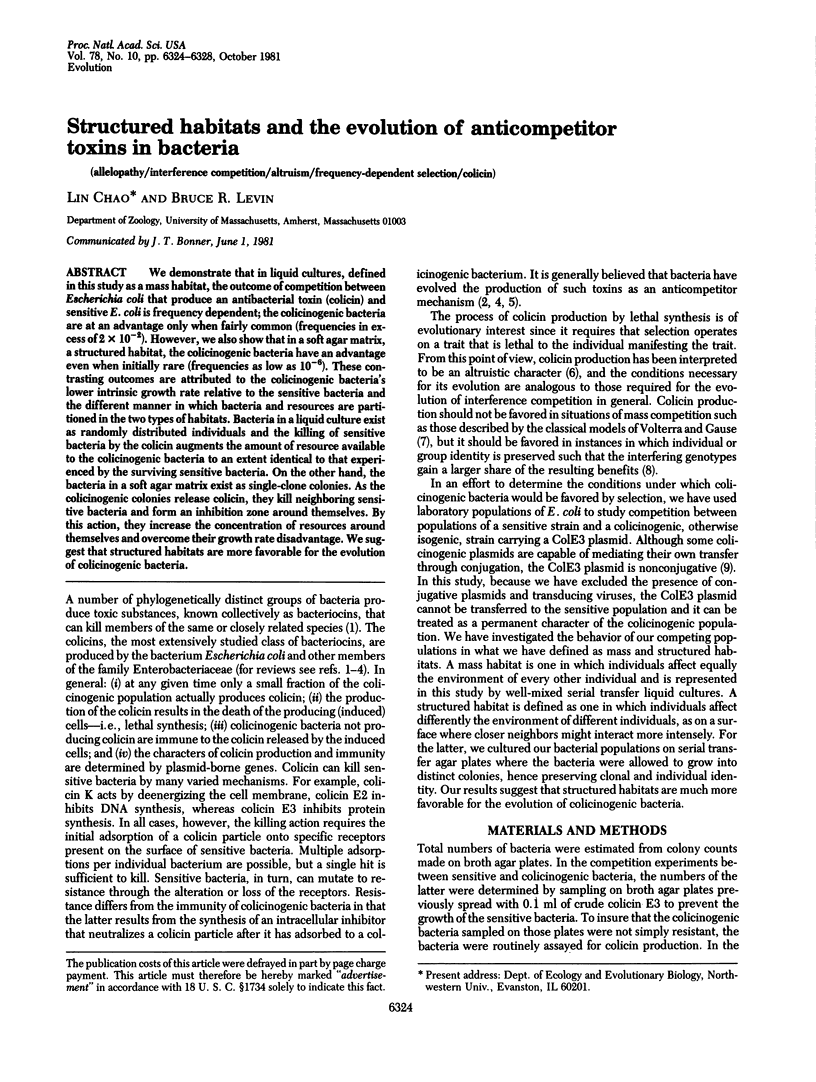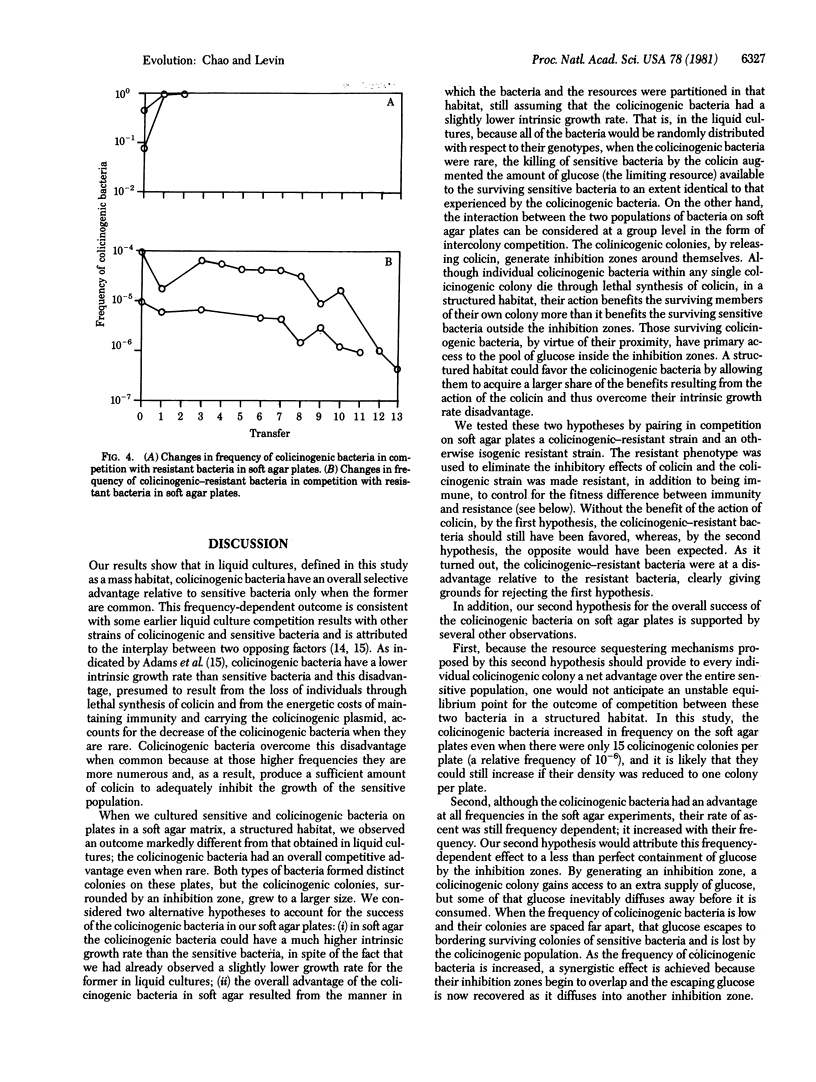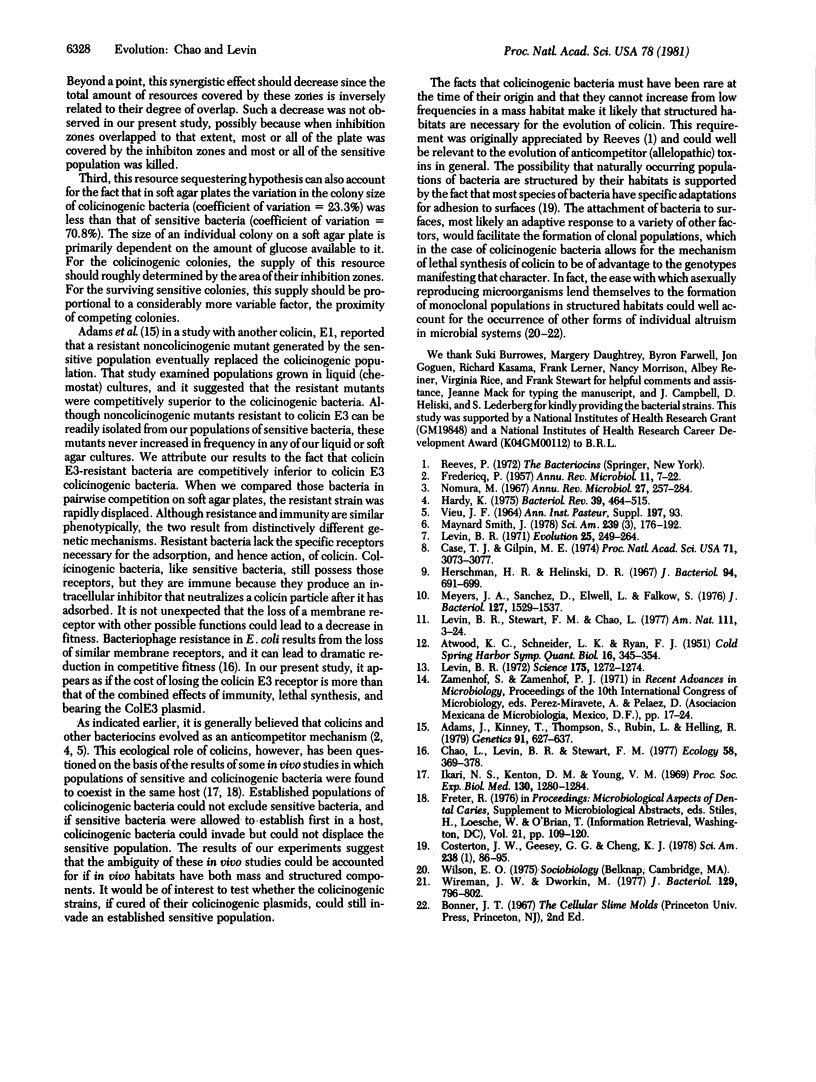Abstract
We demonstrate that in liquid cultures, defined in this study as a mass habitat, the outcome of competition between Escherichia coli that produce an antibacterial toxin (colicin) and sensitive E. coli is frequency dependent; the colicinogenic bacteria are at an advantage only when fairly common (frequencies in excess of 2 X 10(-2)). However, we also show that in a soft agar matrix, a structured habitat, the colicinogenic bacteria have an advantage even when initially rare (frequencies as low as 10(-6)). These contrasting outcomes are attributed to the colicinogenic bacteria's lower intrinsic growth rate relative to the sensitive bacteria and the different manner in which bacteria and resources are partitioned in the two types of habitats. Bacteria in a liquid culture exist as randomly distributed individuals and the killing of sensitive bacteria by the colicin augments the amount of resource available to the colicinogenic bacteria to an extent identical to that experienced by the surviving sensitive bacteria. On the other hand, the bacteria in a soft agar matrix exist as single-clone colonies. As the colicinogenic colonies release colicin, they kill neighboring sensitive bacteria and form an inhibition zone around themselves. By this action, they increase the concentration of resources around themselves and overcome their growth rate disadvantage. We suggest that structured habitats are more favorable for the evolution of colicinogenic bacteria.
Full text
PDF




Images in this article
Selected References
These references are in PubMed. This may not be the complete list of references from this article.
- ATWOOD K. C., SCHNEIDER L. K., RYAN F. J. Selective mechanisms in bacteria. Cold Spring Harb Symp Quant Biol. 1951;16:345–355. doi: 10.1101/sqb.1951.016.01.026. [DOI] [PubMed] [Google Scholar]
- Adams J., Kinney T., Thompson S., Rubin L., Helling R. B. Frequency-Dependent Selection for Plasmid-Containing Cells of ESCHERICHIA COLI. Genetics. 1979 Apr;91(4):627–637. doi: 10.1093/genetics/91.4.627. [DOI] [PMC free article] [PubMed] [Google Scholar]
- Case T. J., Gilpin M. E. Interference competition and niche theory. Proc Natl Acad Sci U S A. 1974 Aug;71(8):3073–3077. doi: 10.1073/pnas.71.8.3073. [DOI] [PMC free article] [PubMed] [Google Scholar]
- Costerton J. W., Geesey G. G., Cheng K. J. How bacteria stick. Sci Am. 1978 Jan;238(1):86–95. doi: 10.1038/scientificamerican0178-86. [DOI] [PubMed] [Google Scholar]
- FREDERICQ P. Colicins. Annu Rev Microbiol. 1957;11:7–22. doi: 10.1146/annurev.mi.11.100157.000255. [DOI] [PubMed] [Google Scholar]
- Hardy K. G. Colicinogeny and related phenomena. Bacteriol Rev. 1975 Dec;39(4):464–515. doi: 10.1128/br.39.4.464-515.1975. [DOI] [PMC free article] [PubMed] [Google Scholar]
- Herschman H. R., Helinski D. R. Comparative study of the events associated with colicin induction. J Bacteriol. 1967 Sep;94(3):691–699. doi: 10.1128/jb.94.3.691-699.1967. [DOI] [PMC free article] [PubMed] [Google Scholar]
- Ikari N. S., Kenton D. M., Young V. M. Interaction in the germfree mouse intestine of colicinogenic and colicin-sensitive microorganisms. Proc Soc Exp Biol Med. 1969 Apr;130(4):1280–1284. doi: 10.3181/00379727-130-33773. [DOI] [PubMed] [Google Scholar]
- Levin B. R. Coexistence of two asexual strains on a single resource. Science. 1972 Mar 17;175(4027):1272–1274. doi: 10.1126/science.175.4027.1272. [DOI] [PubMed] [Google Scholar]
- Meyers J. A., Sanchez D., Elwell L. P., Falkow S. Simple agarose gel electrophoretic method for the identification and characterization of plasmid deoxyribonucleic acid. J Bacteriol. 1976 Sep;127(3):1529–1537. doi: 10.1128/jb.127.3.1529-1537.1976. [DOI] [PMC free article] [PubMed] [Google Scholar]
- Nomura M. Colicins and related bacteriocins. Annu Rev Microbiol. 1967;21:257–284. doi: 10.1146/annurev.mi.21.100167.001353. [DOI] [PubMed] [Google Scholar]
- Wireman J. W., Dworkin M. Developmentally induced autolysis during fruiting body formation by Myxococcus xanthus. J Bacteriol. 1977 Feb;129(2):798–802. doi: 10.1128/jb.129.2.798-802.1977. [DOI] [PMC free article] [PubMed] [Google Scholar]



